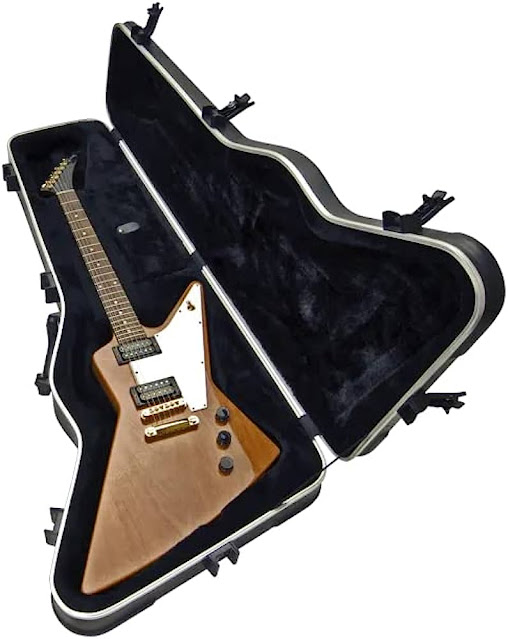Explorers in modern rock and metal bands:
The Gibson Explorer continues to be a popular choice among contemporary rock and metal bands, serving as a go-to instrument for musicians seeking powerful tones, aggressive playing styles, and a visually striking presence on stage.
In modern rock bands, guitarists embrace the Explorer’s raw and punchy sound to deliver hard-hitting riffs, soaring leads, and energetic performances. The guitar’s high-output pickups and solid construction allow for tight, articulate tones that cut through the mix, making it ideal for creating powerful and catchy guitar-driven hooks. Bands like Royal Blood and Highly Suspect have incorporated the Explorer’s dynamic and powerful sound into their modern rock soundscapes, contributing to their signature styles.
In the metal realm, the Explorer continues to be a staple for guitarists in various subgenres. From thrash to progressive metal, the guitar’s aggressive tone, fast-playing capabilities, and striking aesthetics make it a favored choice. Artists like Matt Heafy of Trivium and Jake Bowen of Periphery have utilized the Explorer’s high-gain capabilities and modern metal tone to deliver crushing riffs, intricate solos, and complex compositions that define their respective genres.
Explorers in the hands of emerging guitarists:
Emerging guitarists are also drawn to the Explorer for its unique sound and visual impact, using it as a tool to establish their own musical identities and stand out in the crowded music scene.
In the alternative and indie rock scenes, emerging guitarists embrace the Explorer’s versatility to create their own distinctive sounds. They explore a wide range of tones, from jangly cleans to gritty overdrives, adding a touch of individuality to their music. The Explorer’s iconic design further contributes to their visual appeal, helping them make a statement on stage and in promotional materials.
Explorers in experimental and avant-garde music:
The Explorer’s unconventional design and versatile sound have found their place in experimental and avant-garde music. Musicians in these genres often seek to challenge traditional notions of sound and composition, and the Explorer provides a platform for sonic experimentation.
In experimental music, artists utilize the Explorer’s unique tonal capabilities to explore unconventional playing techniques, extended techniques, and the integration of effects and electronics. The guitar’s aggressive and distinctive sound serves as a canvas for sonic exploration, allowing musicians to create textured soundscapes, atmospheric layers, and dissonant tones.
Avant-garde guitarists, such as those involved in free improvisation and contemporary classical music, appreciate the Explorer’s ability to deliver both subtle nuances and explosive bursts of sound. The guitar’s versatility enables them to navigate a wide range of musical expressions, from delicate and intricate passages to chaotic and intense sonic explorations.
Use of Explorers in fusion and progressive genres:
Explorers have found a place in fusion and progressive genres, where musicians often demand technical precision, tonal versatility, and a balance between complexity and melodic sensibility.
In fusion music, the Explorer’s ability to deliver both articulate clean tones and high-gain leads makes it a versatile instrument for guitarists looking to blend elements of jazz, rock, and other genres. The guitar’s fast-playing capabilities and ability to articulate complex chord voicings and intricate solos enable musicians to navigate the genre’s demanding improvisational nature.
Progressive rock and metal musicians also gravitate towards the Explorer for its ability to handle complex compositions, odd time signatures, and intricate arrangements. The guitar’s ergonomic design and comfortable playability allow for the execution of technical passages, intricate melodies, and extended instrumental sections.
Artists in these genres, such as Tosin Abasi of Animals as Leaders and Guthrie Govan, have harnessed the Explorer’s capabilities to deliver virtuosic performances, blending technical proficiency with musicality and pushing the boundaries of their respective genres.
In conclusion, the Gibson Explorer continues to have a significant presence in contemporary music, particularly in rock and metal genres. It remains a favored choice among emerging guitarists who seek powerful tones and distinctive aesthetics to establish their musical identities. The Explorer’s versatility has also made it a go-to instrument in experimental and avant-garde music, enabling musicians to explore new sonic territories. Additionally, the guitar’s tonal range, comfortable playability, and dynamic capabilities have made it a staple in fusion and progressive genres. As emerging and established artists continue to push the boundaries of contemporary music, the Explorer remains a reliable companion for those seeking sonic exploration, technical proficiency, and visual impact.





